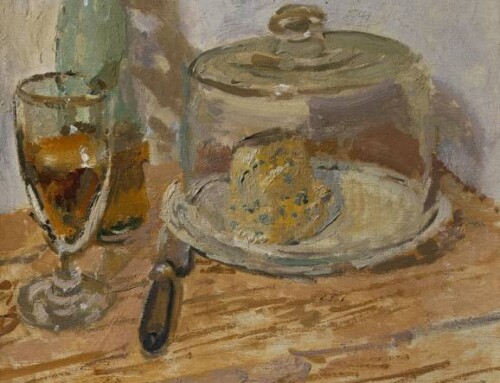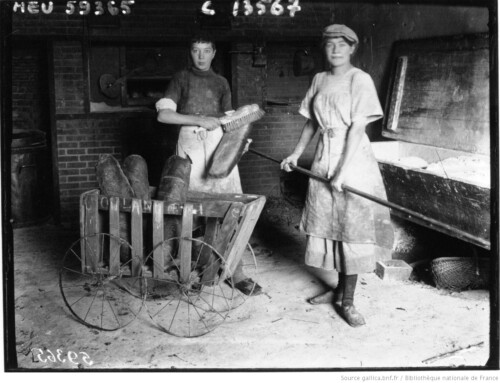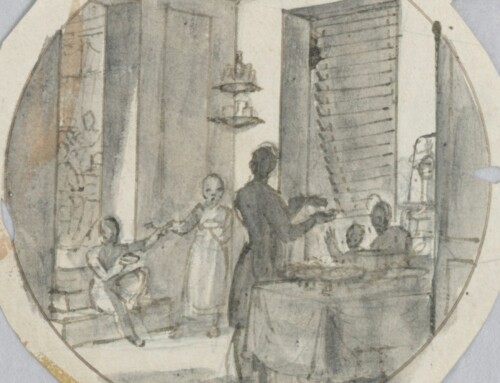While studying in Paris from 1899 to 1902, Meta Vaux Warrick Fuller (1877 – 1968) impressed Auguste Rodin (1840 – 1917) when he saw her sculpture Homme qui a faim, aka Man Eating His Heart, aka Silent Sorrow, aka Secret Sorrow (c. 1900/1901), which drew inspiration from the poem “In the desert” (1895) by Stephen Crane (1871 – 1900):
In the desert
I saw a creature, naked, bestial,
Who, squatting upon the ground,
Held his heart in his hands,
And ate of it.
I said, “Is it good, friend?”
“It is bitter — bitter,” he answered;
“But I like it
“Because it is bitter,
“And because it is my heart.”
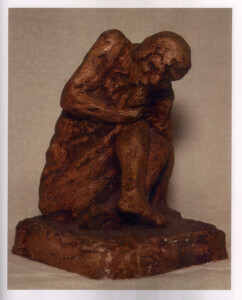
Meta Vaux Warrick Fuller (1877-1968). Man Eating His Heart or Secret Sorrow. Circa 1900. Roots and Routes: Art of the African Diaspora → https://artdiaspora.omeka.net/items/show/12
The above sculpture and poem can make an opposite notion come to mind, such as “Μὴ ἐσθίειν τὴν καρδίαν” (“Cor ne edito” in Latin) attributed to Pythagoras (c. 570 BC – c. 495 BC) — click here for an English translation of what Erasmus (1466 – 1536) wrote regarding that adage, which can then lead one to think of Psalm 37:8 “Cease from anger, and forsake wrath; Do not fret—it only causes harm” (New King James Version).

French (anonymous), early 16th century. “Do Not Eat Your Heart Out” [fol. 22 recto], c.1512/1515. Woodner Collection. The National Gallery of Art, Washington D.C. → https://www.nga.gov/collection/art-object-page.86036.html
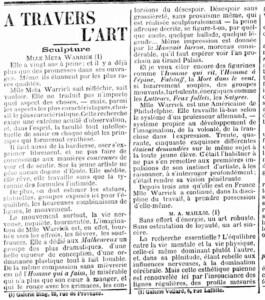
La Fronde. 26 juin 1902. Page 2. Bibliothèque nationale de France → https://gallica.bnf.fr/ark:/12148/bpt6k6705775k/f2.item.r=meta%20warrick,%20rodin.zoom#
▀▄▀▄▀▄
References & Suggested Reading
“A travers l’art.” La Fronde. 26 juin 1902. https://gallica.bnf.fr/ark:/12148/bpt6k6705775k/f2.item.r=meta%20warrick,%20rodin.zoom#
Ater, Renée, and Meta Warrick Fuller. Remaking Race and History: The Sculpture of Meta Warrick Fuller. United Kingdom, University of California Press, 2011.
Bland, Robert. Proverbs, Chiefly Taken from the Adagia of Erasmus, with Explanations and Further Illustrated by Corresponding Examples from the Spanish, Italian, French & English Languages. United Kingdom, T. Egerton, 1814. https://www.google.com/books/edition/Proverbs_Chiefly_Taken_From_The_Adagia_O/AchaAAAAcAAJ?hl=en&gbpv=1&dq=Cor%20ne%20edito&pg=PA7&printsec=frontcover&bsq=Cor%20ne%20edito
Brawley, Benjamin. “A Famous Negro Sculptor.” The Kansas City Sun. January 19, 1918. https://chroniclingamerica.loc.gov/lccn/sn90061556/1918-01-19/ed-1/seq-1/
– – – . The Negro in Literature and Art in the United States. New York: Duffield & Company, 1921.
Crane, Stephen. The Black Riders and Other Lines. Boston: Copeland & Day, 1895.
Davidson, Benjamin, and Pippa Biddle. “The Sculpture of Meta Vaux Warrick Fuller.” The Magazine ANTIQUES. 13 October 2020. https://www.themagazineantiques.com/article/the-sculpture-of-meta-vaux-warrick-fuller/
Demoulins, François, and Jean Michel Massing. Erasmian Wit and Proverbial Wisdom: An Illustrated Moral Compendium for François I: Facsimile of a Dismembered Manuscript with Introduction and Description. United Kingdom, Warburg Institute, University of London, 1995.
Denis, Françoise. « Cœur arraché / Cœur mangé : modulations. » Études littéraires, volume 31, numéro 1, automne 1998, pp. 95-108. https://doi.org/10.7202/501226ar
Doueihi, Milad. “Apertum Pectus: Emblems of the Heart and the Secrets of Interiority.” New Directions in Emblem Studies. Edited by Amy Wygant. United Kingdom, University of Glasgow (Department of French), 1999, pp. 25-41.
Farrington, Lisa E. Creating Their Own Image: The History of African-American Women Artists. United Kingdom, Oxford UP, 2005.
“Fuller, Meta Warrick.” Harlem Renaissance Lives from the African American National Biography. United Kingdom, Oxford UP, 2009.
Hoover, Velma J. “Meta Vaux Warrick Fuller: Her Life and Art.” Negro History Bulletin, vol. 40, no. 2, Association for the Study of African American Life and History, 1977, pp. 678-81. JSTOR, https://www.jstor.org/stable/44176711.
“Man Eating Out His Heart, (sculpture).” Smithsonian Institution. https://siris-artinventories.si.edu/ipac20/ipac.jsp?&profile=ariall&source=~!siartinventories&uri=full=3100001~!27574~!0#focus
“The Meta Vaux Warrick Fuller Collection.” Danforth Art Museum, Framingham University. https://danforth.framingham.edu/exhibition/meta-fuller/
“Meta Vaux Warrick Fuller, PMSIA Class of 1898.” University of the Arts. https://library.uarts.edu/archives/alumni/warrickfuller.html
“Meta Warrick Fuller.” UNLADYLIKE2020, Unladylike Productions, LLC, 2020. https://unladylike2020.com/profile/meta-warrick-fuller/. December 29, 2021.
“Meta Warrick Fuller: Trailblazing African American Sculptor and Poet.” Public Broadcasting System. https://www.pbs.org/wnet/americanmasters/she-was-trailblazing-african-american-sculptor-s2wd1i/14031/
Mynors, Roger Aubrey Baskerville, and Desiderius Erasmus. Adages. Translated by Margaret Mann Phillips. Canada, University of Toronto Press, 1982.
“Psalm 37:8.” Bible Hub. https://biblehub.com/psalms/37-8.htm
Robert, Aurélien. “Pythagoras’ Ethics and the Pythagorean Way of Life in the Middle Ages.” Brill’s Companion to the Reception of Pythagoras and Pythagoreanism in the Middle Ages and the Renaissance. Edited by Irene Caiazzo, Constantinos Macris, and Aurélien Robert. Netherlands, Brill, 2021, pp. 229-276.
